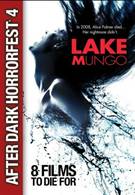Lake Mungo has been spoken of in terms of Blair Witch and Paranormal Activity but it's really a bird of a different feather. Not simply a "found footage" film, it's more like a segment you would see on NBC's Dateline rather than a first person camcorder account of escalating terror. Presented as a factual documentary, the film chronicles the mysterious events that occurred following the accidental drowning of 16 year old Alice Palmer. In the weeks and months after her body was discovered, the grieving Palmer family began to experience paranormal experiences in and around their home and learned that their daughter had many more secrets than they could imagine. The film is mostly made up of talking-head interviews, home videos, and family snapshots. As such, it's not a film that will appeal to everyone. There are those who will have little patience for a movie using this kind of documentary format. There are others who will feel cheated that the supposedly "true" story being told is complete fiction. However, if you can accept the format as a unique vessel for the story, the film has a very intriguing one to tell and is extremely well crafted. That the film can be as unsettling and as wholly believable as it is testifies to the talents of writer-director Joel Anderson and his cast. The film seems totally authentic. The suspension of disbelief is completely achieved. It's actually quite difficult to imagine that this isn't a true story, and that the actors playing the tragic Palmers are not exactly who they say they are.
It would be hard to find a movie that was as quiet and still as this one. Indeed, Lake Mungo's hypnotic power lies in its Zen-like pacing. Between the soft-spoken interviews and slow, unsettling zooms into eerie photos are poetic images of the lake reflecting the slow-moving clouds above, of Alice's empty room, or of a starry night draped over the lonely house, all seemingly placed to allow the viewer the headspace to process the information being doled out and to consider their own feelings about the Palmers and the very concept of life after death. It is a reflective film, not an aggressive one. There are no sudden scares or bloody murders. What the film does is create a slow, nearly overwhelming feeling of loss and dread. This dread reaches a boiling point when Alice's cellphone is discovered hidden away at Lake Mungo. The video that is played back contains a chilling image that seems to hint at a far stranger, more complex answer to the film's mysteries.
Far better made than the rudimentary Paranormal Activity , the film achieves its effects much more subtly. Dime-store demons aren't challenged to show themselves, nor are human footprints found on the Palmer's floor. Paranormal was a film that I forgot about the moment the lights came up in the theater. It's horrors were those of campfire tales and Halloween hayrides. Lake Mungo's horrors are far more disturbing as they center on very real fears of both the living and the dead. Even more impressively, it does a superb job of conveying the pain and turmoil a family experiences following the sudden, premature death of a loved one. This is a film that stayed with me for days afterward. Lake Mungo has been released to DVD under the After Dark Horrorfest label. It doesn't quite fit in with the more conventional and obvious horrors of the fest's other titles and may disappoint any viewers confusing it for an old-fashioned "cabin by the lake" slasher flick.
The film is presented in 1.78:1 anamorphic widescreen, featuring a mixture of documentary-style 16mm and 35mm film and low-res video footage. The variable quality is intrinsic to the film's documentary style, and each format is convincingly replicated, from old home movies to low-res cellphone video. The audio is 5.1 Dolby Digital. The only extras included are the producer's original trailer and the newer one made for the After Dark Horrorfest. C'mon, After Dark, gives us some extras on these discs!
There is one odd and unexplained aspect of this DVD release. Lake Mungo is an Australian film and was released on DVD earlier in that country at 84 minutes. A version appeared to play the European festival circuit at 87 minutes. This version runs 104 minutes. Having never seen the original version, I do not know what makes up the difference. At the very least, it can be assumed that this is an "Extended Version" of some kind.
Your Daily Blend of Entertainment News

